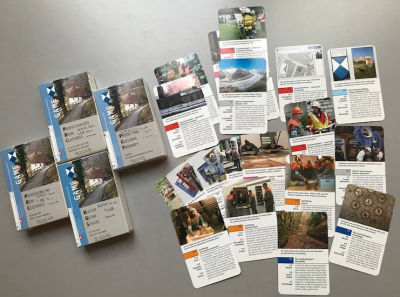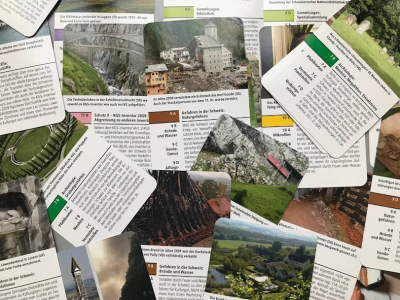"Can you please give me 12B?"
"No chance! But I'd like you to give me the 8A please - all I'm missing are the steamships!"
Time in our library is usually spent on study, research and cataloguing but shortly before the end-of-year holiday it passed a bit differently, as the team treated themselves to cups of tea and homemade biscuits… accompanied by a few rounds of a game from our collection.
A game, you ask. Yes, among all the books you can find a few games dealing with cultural heritage and its conservation. After all, learning through play is not only fun, but also stimulating and can lead to lasting success – in this case by raising awareness of the need to protect our heritage.
The game in question is a take on the card-based classic known as Quartets, where the object is to win sets of four. This version was published in four languages by the Protection of Cultural Property Section (PCP) of the Federal Office for Civil Protection (FOCP) in Switzerland in 2012. The PCP is the responsible institution dealing with national and international heritage protection.
Several features of the cards contribute to the enjoyment of the game, from the good quality paper to the appealing photos and interesting information on the different aspects of cultural heritage protection. Its 15 quarts cover the following themes:
- Worldwide destruction of cultural property
- UNESCO Conventions
- Legal bases for PCP
- What is cultural property?
- Buildings
- Collections
- Archaeology
- Special cases
- Hazards in Switzerland
- Protection 1: measures
- Protection II: PCP Inventory
- Training
- Partners I: fire services
- Partners II International and national
- Information and awareness raising
A decade on from when these games were published, museums and heritage sites increasingly devise playful ways for their youngest audiences to discover collections, while various digital resources and apps have been developed to awaken interest in cultural heritage among children and young people. However, much more can always be done to inspire new generations to cherish these things.
If you have children or grandchildren, shared experiences are a great start, whether it’s a round of themed cards or rediscovering cultural heritage in other ways. What’s important is to make the time, otherwise we risk losing what matters most. But when we play together, it is always time well spent!


